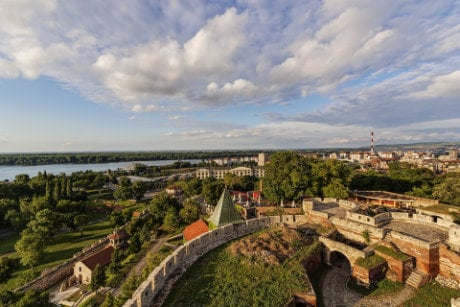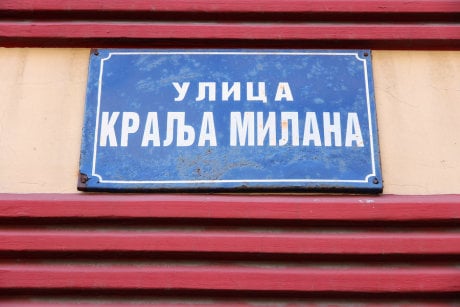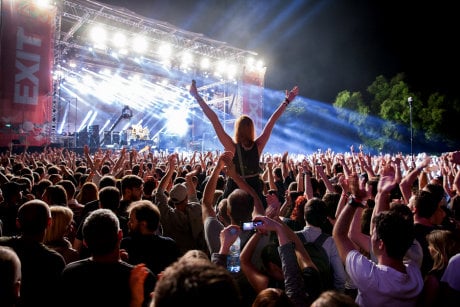Find out a little about Serbia with the kids and then enjoy our flag printables (including colouring page, bookmarks and various sizes of flag to print).

Belgrade fortress and a panoramic view of Serbia's capital city
Geography of Serbia
- The Republic of Serbia is a landlocked country in South Eastern Europe.
- It shares a border with Hungary, Romania and Croatia to the north across the Pannonian floodplain, in addition to Croatia, Montenegro, Macedonia and Kosovo.
- The Balkan mountains form the border with Bulgaria and Romania, with the Dinaric Alps and valleys on the west.
A Little History
- Serbia means "the land of the Serbs". The Serbs were Slavs who colonised the area in the 6th century CE.
- This region was the birthplace of 17 Roman Emperors including Constantine! The only country to have provided more Roman Emperors was Italy.
- Serbia played a key role in Yugoslavia, which was a federation of Balkan states. It started as a Kingdom but became a Socialist state after 1949, under Tito.
The Capital City, Belgrade
- Belgrade, the capital, is one of Europe’s oldest cities. Nearby Vinca was a major Neolithic settlement dating to 5,700 BCE. Located at the junction of the Danube and Sava Rivers, in a strategic location, the city has been occupied by 40 different armies and destroyed many times.
- Belgrade is protected by an ancient fortress which was once home to a Roman legion. The Serbian name for Belgrade is "Beograd", which means white fortress or town.
- Modern Belgrade is home to over 20% of Serbia’s 7.5m people. Street signs are written using the cyrillic alphabet, which can be confusing to visitors.

Serbian street sign in the cyrillic alphabet - translating as King Milan Street
Some Interesting Facts
- Most Serbians are Eastern Orthodox Christians. They celebrate Christmas Day on 7th January as they use the old Julian Calendar. For dinner they eat a dish called ‘pecenica’, which is roasted pig, followed by a special cake containing a coin.
- In the hills around Fruskla Doro, 35 monasteries were built from the 15th to 18th centuries to defend the Serbian culture against the Turks. Sixteen monasteries remain today.
- Serbia has over 300 species of bird. Each 1st May, on the Great Day of Birds, people compete to count the most species within a circle of 50 metres!
- Prince Marko is a Serbian folk hero celebrated throughout the Balkans. He was a real person and King of Serbia in the late 14th century. Stories of his fictional exploits record his talking horse Sarac!
- Nicola Tesla was a famous Serbian, although born in Croatia. He invented alternating current (AC), which allows electricity to travel long distances, and the tesla coil used in radios. Belgrade Airport is named after him.
- Serbians love to eat grilled meat. Cevapcici is made from minced beef or pork and onions, cooked over a fire. It is found across the Balkans.
- Basketball is one of the nations favourite sports and Serbia won the World Cup in 2002.
- Serbia has produced many leading tennis players including Novak Djokovic and Ana Ivanovic.
- One of Europe’s top music festivals, EXIT, takes place each year at the historic Petrovaradin Fortress on the banks of the Danube in Novi Sad. It was voted the best large festival in Europe in 2014.

About the Serbian Flag

The Serbian flag is made up of a coat of arms against red, blue and white horizontal stripes. The Serbia Coat of Arms consists of a white double-headed eagle against a red shield. The flag of Serbia was officially adopted in November 2010.
Our Serbia Activities
Print out our little booklet with the flag of Serbia on the front. It's a fun place to store your facts and research on the country! Folding instructions are here.
We have four sets of Serbia bookmarks featuring the country's flag. Two are in colour, two in black and white for the kids to colour in.
We've provided a list facts for the kids to find about Serbia on this worksheet, as well as some location practise.
You'll need red, white and blue to colour in the Serbian flag.
Our flag jigsaws are a great way to help children remember the flags of the world. This one features the flag of Serbia. Instructions and cutting guides are here.
Whether you are celebrating a national day, learning about the world or celebrating a sporting event, flags are always useful and there are five different size flags to print on our Serbia flag printable.
Discover the location and capital city of Serbia with our guided worksheet, or test the kids with our blank location worksheet!
Here are two notebooking pages - one with space for a map or drawing - for your Serbia studies.
Print this map of Europe, which clearly shows Serbia's location within the continent.
Kids can use our simple worksheet to record what they've learned about Serbia.



